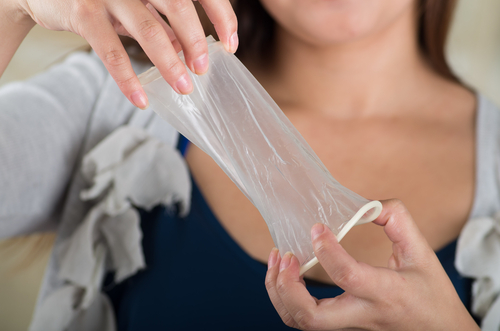There are a plethora of birth control contraceptives on the market. Still, many don’t know about the female condom. Though there are some higher in popularity than others, the female condom (also known as an internal condom) is slowly becoming a preference for contraceptives amongst women.
What Is a Female Condom?
Contrary to the male condom, which covers an erect penis before sex, the female condom is inserted into the vagina before sex. It acts as a boundary between sperm and the uterus to prevent pregnancy and sexually transmitted diseases and infections.

The female condom is a soft pouch that sits inside the vagina. This internal condom is effective at preventing sexually transmitted diseases and unplanned pregnancy. The pouch is a barrier that protects the vagina and prevents sperm from entering the uterus.
Additionally, this form of birth control gives women the power to put on a condom themselves for protection. It doesn’t affect hormones like the birth control pill, and it is temporary, unlike a copper IUD.
Similarly, a female condom is effective during anal sex to prevent sexually transmitted infections.
How Do You Use a Female Condom?
Inserting a female condom is similar to inserting a tampon without an applicator, for example. It has a cylindrical shape with an open ring on one end and a closed ring on the other end.
- Firstly, squeeze the sides of the closed ring with your thumb and forefinger.
- Insert the closed ring into the vagina.
- Push the ring as far up as you can against your cervix.
- The open ring sits on the outside of the vagina. It acts as an anchor to keep it in place.
- The penis should go into the outer ring of the condom and never on the outside of it.
- To remove, twist the outer ring and pull out.
- Discard and do not reuse.
There are only two female condoms approved by the Food and Drug Administration in the United States. FC1 and the revamped FC2 can be found at drug stores, health clinics, or family planning clinics.
Pros and Cons of the Female Condom
However, like all contraceptives, there are a few pros and cons. A few pros include:
- Both FC1 and FC2 are both latex-free for those who are allergic
- You can keep the condom in for up to 8 hours before being intimate
- It allows couples to switch from foreplay to intimacy quickly freely
- This form of contraceptive is 95% effective in preventing pregnancy
- It can be removed immediately, unlike a cervical cap
Some of the cons are:
- First-time use may be awkward
- It can make a squeaky noise but can be prevented with extra lubricant
- They can be difficult to find
- It can be expensive
Risks
Female condoms are not 100% effective. With typical use, up to 21 out of 100 women will get pregnant. This higher rate could be due to product failure or incorrect use.
- It can break or tear
- It slips out of the vagina
- The product isn’t used at all
- The penis enters to the side of the ring
- The outer ring gets pushed into the vagina
Since the female condom is made with nitrate, it is more durable than a male condom made with latex. Nitrate also warms with the body creating a more natural and sensual sexual experience.
It is imperative not to use a male condom with a female condom. Though it sounds like a great idea for extra protection, this can cause tears in the contraceptives, which you do not want. If this happens, emergency contraception may be necessary.
The female condom is a great contraceptive to try for couples who are looking for a new and different way of protection. Baby oil, petroleum jelly, and other oil-based lubricants damage latex, so do not use these if you are using a latex product.
For any questions about sex, contraceptives, or your overall feminine health, call Cool Springs OBGYN today at 615.690.6600. Dr. Lett is an established gynecologist in the Cool Springs and Franklin, Tennessee area. Dr. Lett and his health care team can recommend the right methods of birth control for your needs.
Read more about the female condom and other obstetrics and gynecology topics at the U.S. Department of Health and Human Services.

